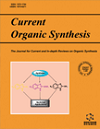- Home
- A-Z Publications
- Current Organic Synthesis
- Previous Issues
- Volume 16, Issue 5, 2019
Current Organic Synthesis - Volume 16, Issue 5, 2019
Volume 16, Issue 5, 2019
-
-
Synthetic Approaches Towards Antihypercholesterolemic Drug Simvastatin
More LessAuthors: Tanzeela A. Fattah, Aamer Saeed and Syeda A. ShehzadiCardiovascular diseases are among the most threatening problems being faced by twenty-first century humans. The core cause of these diseases is high cholesterol level. Simvastatin (1: Synvinolin) is a well-known cholesterol-lowering drug marketed under the trade name Zocor®, which significantly reduces the risk of cardiovascular diseases related to hypercholesterolemia and is effective in lowering the total plasma cho Read More
-
-
-
Recent Progress in the Synthesis of Quinolines
More LessBy Duc D. XuanBackground: Quinoline-containing compounds present in both natural and synthetic products are an important class of heterocyclic compounds. Many of the substituted quinolines have been used in various areas including medicine as drugs. Compounds with quinoline skeleton possess a wide range of bioactivities such as antimalarial, anti-bacterial, anthelmintic, anticonvulsant, antiviral, anti-inflammatory, and analgesic activity Read More
-
-
-
1,4-Diazepines: A Review on Synthesis, Reactions and Biological Significance
More LessBackground: 1,4-Diazepines are two nitrogen containing seven membered heterocyclic compounds and associated with a wide range of biological activities. Due to its medicinal importance, scientists are actively involved in the synthesis, reactions and biological evaluation of 1,4-diazepines since number of decades. Objective: The primary purpose of this review is to discuss the synthetic schemes and reactivity of 1,4- diazepi Read More
-
-
-
A Green Approach for Organic Transformations Using Microwave Reactor
More LessAuthors: Subrata Das, Rupak Banik, Brajesh Kumar, Subhadip Roy, Noorussabah, Khursheed Amhad and Pradip K. SukulMicrowave-assisted organic transformation (MAOR) is presently gaining wide popularity in the field of organic synthesis. The conventional heating technique is gradually being removed from the laboratory and a novel microwave heating technique established to be used in both academia and industry. As compared to the classical organic methodology, the green technology tools have several advantages like dramatically reduc Read More
-
-
-
Preparation of Carbon-14 Labeled 2-(2-mercaptoacetamido)-3-phenylpropanoic Acid as Metallo-beta-lactamases Inhibitor (MBLI), for Coadministration with Beta-lactam Antibiotics
More LessAim and Objective: Bacteria could become resistant to β-lactam antibiotics through production of β- lactamase enzymes like metallo-β-lactamase. 2-(2-mercaptoacetamido)-3-phenylpropanoic acid was reported as a model inhibitor for this enzyme. In order to elucidate the mechanism of action in the body’s internal environment, preparation of a labeled version of 2-(2-mercaptoacetamido)-3-phenylpropanoic acid finds importan Read More
-
-
-
Synthesis and Neuroprotective Biological Evaluation of Quinazolinone Derivatives via Scaffold Hopping
More LessAuthors: Fan Yang, Wei-Ping He, Jia-Qi Yao, Dong Zou, Pu Chen and Jie LiObjective: To develop efficient method for the synthesis of quinazolinone derivatives bearing different functional groups on ring A and ring B and evaluation as neuroprotective agents. Methods: Synthetic route to quinazolinone derivatives was furnished by condensation/cyclocondensation/ reduction sequence of the activated N-acylbenzotriazoles. The structures of the targets compounds have been deduced upon their spec Read More
-
-
-
Synthesis of Dihydropyrimidinones (DHPMs) and Hexahydro Xanthene Catalyzed by 1,4-Diazabicyclo [2.2.2] Octane Triflate Under Solvent-Free Condition
More LessAuthors: Deepa, Geeta D. Yadav, Mohd J. Aalam, Pooja Chaudhary and Surendra SinghObjective: DABCO salts were evaluated as catalysts for the Biginelli reaction between 4- methoxybenzaldehyde, urea and ethyl acetoacetate under solvent-free conditions. 1,4-Diazabicyclo [2.2.2] octane triflate was found to be a simple, inexpensive, highly efficient catalyst for Biginelli reaction for a variety aromatic aldehyde with urea and ethyl acetoacetate at 80°C afforded corresponding 3,4-dihydropyrimidinones in 50-99% yi Read More
-
-
-
Cationic Ruthenium-Catalyzed Bis-Homo-Diels-Alder Cycloaddition
More LessAuthors: Dina Petko, Matthew Stratton, Samuel Koh and William TamObjective: The ruthenium-catalyzed Bis-Homo-Diels-Alder cycloaddition between 1,5- cyclooctadiene and alkynes was explored, and the use of commercially available cationic catalysts was investigated. It was noted that [CpRu(CH3CN)3]PF6 was effective at catalyzing this cycloaddition and yields of the desired tricyclo[4.2.2.02,5]dec-7-ene adduct ranging from 13 to 83% were achieved using this cationic catalyst. Several cyc Read More
-
-
-
Expeditious Synthesis of 2-Amino-4H-chromenes and 2-Amino-4H-pyran-3-carboxylates Promoted by Sodium Malonate
More LessAuthors: Mohsen Tazari and Hamzeh KiyaniBackground: Chromenes and pyran annulated heterocycles are the most common frameworks existing in various biologically active molecules. Due to their beneficial and biological properties, they are eyecatching synthetic targets in the arsenal of organic chemistry. Thus, finding green and efficient methods, as well as searching for a new catalyst for the synthesis of these heterocycles is of interest to organic chemistry rese Read More
-
-
-
Synthesis and Antioxidant Activity of Novel 5-amino-2-alkyl/glycosylthio-1,3,4-thiadiazoles: Regioselective Alkylation and Glycosylation of the 5-amino-1,3,4-thiadiazole-2-thiol Scaffold
More LessObjective: 5-Amino-2-alkyl/glycosylthio-1,3,4-thiadiazoles have been synthesized by the reaction of 5-amino-1,3,4-thiadiazole-2-thiol with a variety of alkylating agents or glycosyl halides in the presence of anhydrous potassium carbonate in dry acetone. Methods: The structures of the newly synthesized compounds have been established based on their spectral data (FT-IR, 1H- and 13C-NMR) and mass spectrometry. They wer Read More
-
Volumes & issues
-
Volume 22 (2025)
-
Volume 21 (2024)
-
Volume 20 (2023)
-
Volume 19 (2022)
-
Volume 18 (2021)
-
Volume 17 (2020)
-
Volume 16 (2019)
-
Volume 15 (2018)
-
Volume 14 (2017)
-
Volume 13 (2016)
-
Volume 12 (2015)
-
Volume 11 (2014)
-
Volume 10 (2013)
-
Volume 9 (2012)
-
Volume 8 (2011)
-
Volume 7 (2010)
-
Volume 6 (2009)
-
Volume 5 (2008)
-
Volume 4 (2007)
-
Volume 3 (2006)
-
Volume 2 (2005)
-
Volume 1 (2004)
Most Read This Month
Article
content/journals/cos
Journal
10
5
false
en


